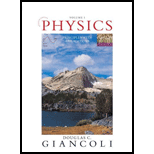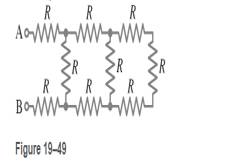
Physics: Principles with Applications
7th Edition
ISBN: 9780321625922
Author: Douglas C. Giancoli
Publisher: Addison-Wesley
expand_more
expand_more
format_list_bulleted
Textbook Question
Chapter 19, Problem 18P
(a) Determine the equivalent resistance of the “ladder” of equal 175-? resistors shown in Fig. 19-49. In other words, what resistance would an ohmmeter read if connected between points A and B? (b) What is the current through each of the three resistors on the left if a 50.0-V battery is connected between points A and B?

Expert Solution & Answer
Learn your wayIncludes step-by-step video

schedule10:51
Students have asked these similar questions
Imagine you are out for a stroll on a sunny day when you encounter a lake. Unpolarized light from the sun is reflected off the lake into your eyes. However, you notice when you put on your vertically polarized sunglasses, the light reflected off the lake no longer reaches your eyes. What is the angle between the unpolarized light and the surface of the water, in degrees, measured from the horizontal? You may assume the index of refraction of air is nair=1 and the index of refraction of water is nwater=1.33 . Round your answer to three significant figures. Just enter the number, nothing else.
Deduce what overvoltage is like in reversible electrodes.
pls help on these
Chapter 19 Solutions
Physics: Principles with Applications
Ch. 19 - Prob. 1OQCh. 19 - Prob. 1QCh. 19 - Prob. 2QCh. 19 - Prob. 3QCh. 19 - Prob. 4QCh. 19 - Prob. 5QCh. 19 - Prob. 6QCh. 19 - Prob. 7QCh. 19 - Prob. 8QCh. 19 - Prob. 9Q
Ch. 19 - Prob. 10QCh. 19 - Prob. 11QCh. 19 - Prob. 12QCh. 19 - Prob. 13QCh. 19 - Prob. 14QCh. 19 - Prob. 15QCh. 19 - Given the circuit shown in Fig. 19-38, use the...Ch. 19 - Prob. 17QCh. 19 - Prob. 18QCh. 19 - 19. What is the main difference between an analog...Ch. 19 - What would happen if you mistakenly used an...Ch. 19 - Prob. 21QCh. 19 - Prob. 22QCh. 19 - Prob. 23QCh. 19 - Prob. 1MCQCh. 19 - Prob. 2MCQCh. 19 - Prob. 3MCQCh. 19 - Prob. 4MCQCh. 19 - Prob. 5MCQCh. 19 - Prob. 6MCQCh. 19 - Prob. 7MCQCh. 19 - Prob. 8MCQCh. 19 - Prob. 9MCQCh. 19 - Prob. 10MCQCh. 19 - Prob. 11MCQCh. 19 - Prob. 12MCQCh. 19 - Prob. 13MCQCh. 19 - Prob. 14MCQCh. 19 - Prob. 15MCQCh. 19 - Calculate the terminal voltage for a battery with...Ch. 19 - Prob. 2PCh. 19 - What is the internal resistance of a 12.0-V car...Ch. 19 - A 650-O and an 1800-O resistor are connected in...Ch. 19 - Prob. 5PCh. 19 - Suppose that you have a 580-O, a 790-O, and a...Ch. 19 - Prob. 7PCh. 19 - Prob. 8PCh. 19 - Prob. 9PCh. 19 - Prob. 10PCh. 19 - Prob. 11PCh. 19 - Eight identical bulbs are connected in series...Ch. 19 - Prob. 13PCh. 19 - Prob. 14PCh. 19 - Prob. 15PCh. 19 - Determine (a) the equivalent resistance of the...Ch. 19 - Prob. 17PCh. 19 - (a) Determine the equivalent resistance of the...Ch. 19 - What is the net resistance of the circuit...Ch. 19 - Prob. 20PCh. 19 - Prob. 21PCh. 19 - Prob. 22PCh. 19 - Prob. 23PCh. 19 - Consider the network of resistors shown in Fig....Ch. 19 - Calculate the current in the circuit of Fig....Ch. 19 - Determine the terminal voltage of each battery in...Ch. 19 - For the circuit shown in Fig.19-55, find the...Ch. 19 - Determine the magnitudes and directions of the...Ch. 19 - (a) What is the potential difference between...Ch. 19 - Prob. 30PCh. 19 - 31. (II) Determine the magnitudes V1= 9.0 V R1, =...Ch. 19 - Prob. 32PCh. 19 - Prob. 33PCh. 19 - (a) Determine the currents l1,l2 and l3 in Fig....Ch. 19 - Prob. 35PCh. 19 - Prob. 36PCh. 19 - Prob. 37PCh. 19 - Prob. 38PCh. 19 - A 3.00-F and a 4.00-F capacitor are connected in...Ch. 19 - If 21.0 V is applied across the whole network of...Ch. 19 - The capacitance of a portion of a circuit is to be...Ch. 19 - An electric circuit was accidentally constructed...Ch. 19 - Consider three capacitors, of capacitance 3200...Ch. 19 - Determine the equivalent capacitance between...Ch. 19 - What is the ration of the voltage V1 across...Ch. 19 - A 0.50-F and a 1.4-F capacitor are connected in...Ch. 19 - A circuit contains a single 250-pF capacitor...Ch. 19 - Prob. 48PCh. 19 - Prob. 49PCh. 19 - Given three capacitors. C1= 2.0$ mUF, C2= 1.5 F,...Ch. 19 - Prob. 51PCh. 19 - Prob. 52PCh. 19 - Prob. 53PCh. 19 - In Fig. 19-69 (same as Fig. 19-20a ), the total...Ch. 19 - Prob. 55PCh. 19 - Prob. 56PCh. 19 - Prob. 57PCh. 19 - Two resistors and two uncharged capacitors are...Ch. 19 - Prob. 59PCh. 19 - Prob. 60PCh. 19 - Prob. 61PCh. 19 - A galvanometer has an internal resistance of 32 ...Ch. 19 - Prob. 63PCh. 19 - Prob. 64PCh. 19 - Prob. 65PCh. 19 - Prob. 66PCh. 19 - Prob. 67GPCh. 19 - Prob. 68GPCh. 19 - Prob. 69GPCh. 19 - Prob. 70GPCh. 19 - A heart pacemaker is designed to operate at 72...Ch. 19 - Prob. 72GPCh. 19 - Prob. 73GPCh. 19 - Prob. 74GPCh. 19 - Prob. 75GPCh. 19 - Prob. 76GPCh. 19 - Prob. 77GPCh. 19 - Prob. 78GPCh. 19 - Prob. 79GPCh. 19 - Prob. 80GPCh. 19 - Prob. 81GPCh. 19 - Prob. 82GPCh. 19 - Prob. 83GPCh. 19 - (a) What is the equivlaent resistance of the...Ch. 19 - Prob. 85GPCh. 19 - Prob. 86GPCh. 19 - Prob. 87GPCh. 19 - In Fig. 19-86, let V= 10.0 V and C1=C2=C3=25.4 F....Ch. 19 - 89. A 12.0-V battery, two resistors, and two...Ch. 19 - Prob. 90GPCh. 19 - Prob. 91GPCh. 19 - Prob. 92GPCh. 19 - Prob. 93GPCh. 19 - Prob. 94GPCh. 19 - The variable capacitance of an old radio tuner...Ch. 19 - Prob. 96GPCh. 19 - Prob. 97GP
Additional Science Textbook Solutions
Find more solutions based on key concepts
35. Consider the reaction.
The graph shows the concentration of Br2 as a function of time.
a. Use the g...
Chemistry: Structure and Properties (2nd Edition)
2. Define equilibrium population. Outline the conditions that must be met for a population to stay in genetic e...
Biology: Life on Earth (11th Edition)
WHAT IF? As a cell begins the process of dividing, its chromosomes become shorter, thicker, and individually vi...
Campbell Biology in Focus (2nd Edition)
Define histology.
Fundamentals of Anatomy & Physiology (11th Edition)
The bioremediation process shown in the photograph is used to remove benzene and other hydrocarbons from soil c...
Microbiology: An Introduction
Where are skeletal cartilages located?
Human Anatomy & Physiology (2nd Edition)
Knowledge Booster
Learn more about
Need a deep-dive on the concept behind this application? Look no further. Learn more about this topic, physics and related others by exploring similar questions and additional content below.Similar questions
- pls help on thesearrow_forward20. Two small conducting spheres are placed on top of insulating pads. The 3.7 × 10-10 C sphere is fixed whie the 3.0 × 107 C sphere, initially at rest, is free to move. The mass of each sphere is 0.09 kg. If the spheres are initially 0.10 m apart, how fast will the sphere be moving when they are 1.5 m apart?arrow_forwardpls help on allarrow_forward
- 19. Mount Everest, Earth's highest mountain above sea level, has a peak of 8849 m above sea level. Assume that sea level defines the height of Earth's surface. (re = 6.38 × 106 m, ME = 5.98 × 1024 kg, G = 6.67 × 10 -11 Nm²/kg²) a. Calculate the strength of Earth's gravitational field at a point at the peak of Mount Everest. b. What is the ratio of the strength of Earth's gravitational field at a point 644416m below the surface of the Earth to a point at the top of Mount Everest? C. A tourist watching the sunrise on top of Mount Everest observes a satellite orbiting Earth at an altitude 3580 km above his position. Determine the speed of the satellite.arrow_forwardpls help on allarrow_forwardpls help on allarrow_forward
- 6. As the distance between two charges decreases, the magnitude of the electric potential energy of the two-charge system: a) Always increases b) Always decreases c) Increases if the charges have the same sign, decreases if they have the opposite signs d) Increases if the charges have the opposite sign, decreases if they have the same sign 7. To analyze the motion of an elastic collision between two charged particles we use conservation of & a) Energy, Velocity b) Momentum, Force c) Mass, Momentum d) Energy, Momentum e) Kinetic Energy, Potential Energyarrow_forwardpls help on all asked questions kindlyarrow_forwardpls help on all asked questions kindlyarrow_forward
arrow_back_ios
SEE MORE QUESTIONS
arrow_forward_ios
Recommended textbooks for you

 College PhysicsPhysicsISBN:9781938168000Author:Paul Peter Urone, Roger HinrichsPublisher:OpenStax College
College PhysicsPhysicsISBN:9781938168000Author:Paul Peter Urone, Roger HinrichsPublisher:OpenStax College College PhysicsPhysicsISBN:9781285737027Author:Raymond A. Serway, Chris VuillePublisher:Cengage Learning
College PhysicsPhysicsISBN:9781285737027Author:Raymond A. Serway, Chris VuillePublisher:Cengage Learning Principles of Physics: A Calculus-Based TextPhysicsISBN:9781133104261Author:Raymond A. Serway, John W. JewettPublisher:Cengage Learning
Principles of Physics: A Calculus-Based TextPhysicsISBN:9781133104261Author:Raymond A. Serway, John W. JewettPublisher:Cengage Learning Physics for Scientists and Engineers, Technology ...PhysicsISBN:9781305116399Author:Raymond A. Serway, John W. JewettPublisher:Cengage Learning
Physics for Scientists and Engineers, Technology ...PhysicsISBN:9781305116399Author:Raymond A. Serway, John W. JewettPublisher:Cengage Learning College PhysicsPhysicsISBN:9781305952300Author:Raymond A. Serway, Chris VuillePublisher:Cengage Learning
College PhysicsPhysicsISBN:9781305952300Author:Raymond A. Serway, Chris VuillePublisher:Cengage Learning


College Physics
Physics
ISBN:9781938168000
Author:Paul Peter Urone, Roger Hinrichs
Publisher:OpenStax College

College Physics
Physics
ISBN:9781285737027
Author:Raymond A. Serway, Chris Vuille
Publisher:Cengage Learning

Principles of Physics: A Calculus-Based Text
Physics
ISBN:9781133104261
Author:Raymond A. Serway, John W. Jewett
Publisher:Cengage Learning

Physics for Scientists and Engineers, Technology ...
Physics
ISBN:9781305116399
Author:Raymond A. Serway, John W. Jewett
Publisher:Cengage Learning

College Physics
Physics
ISBN:9781305952300
Author:Raymond A. Serway, Chris Vuille
Publisher:Cengage Learning
How To Solve Any Resistors In Series and Parallel Combination Circuit Problems in Physics; Author: The Organic Chemistry Tutor;https://www.youtube.com/watch?v=eFlJy0cPbsY;License: Standard YouTube License, CC-BY